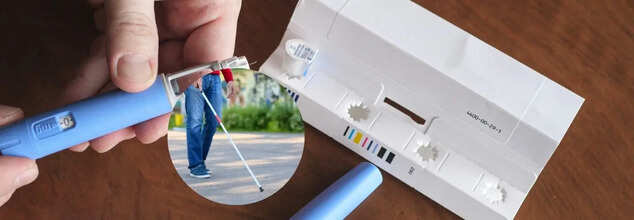- Health Conditions A-Z
- Health & Wellness
- Nutrition
- Fitness
- Health News
- Ayurveda
- Videos
- Medicine A-Z
- Parenting
- Web Stories

Credits: Youtube
This Michigan Man Went From 'The Healthiest In The Room' To Battling A Rare AGGRESSIVE Cancer
When Joe Fornasero, a 34-year-old gym buff from Brighton, Michigan, visited the hospital in 2022, he felt he was as healthy as he could possibly be. For over two decades of eating clean and working out consistently, Joe had every reason to think that his healthy habits would keep him safe from chronic disease. But cancer doesn't care about the rules or so it seemed.
Only weeks into his wedding, Joe got a diagnosis so unusual that even veteran oncologists had hardly ever seen a case. He was diagnosed with Desmoplastic Small Round Cell Tumor (DSRCT)—a virulent cancer with fewer than 200 reported cases around the world since it was first discovered in 1989.
Joe's case started out as what appeared to be a routine post-surgical pain. He had just had a hernia repair and during the operation, a benign growth was taken out. Doctors told him the lingering pain and nerve problems were normal.
But the pain in his belly only grew worse. He had chronic stabbing pain in the lower left quadrant and a profound weariness he initially attributed to pandemic stress and career burnout. It wasn't until a physician-friend friend leaned on him to get to the bottom of it that Joe went to the ER. A single CT scan later, his world was turned upside down.
"I went in thinking I was the healthiest man I knew," Joe recalls. "And I came out with a potential diagnosis of cancer."
Misdiagnosis and Medical Whiplash
The initial pathology indicated small cell carcinoma—commonly found with lung cancer. With no time to lose, Joe checked himself into a hospital and underwent chemotherapy. However, something felt amiss.
He was determined to get answers, so he went to MD Anderson Cancer Center in Houston. There, physicians explained the tumors weren't in his lungs. His actual diagnosis came at the eleventh hour in a meeting with a clinical trials specialist. The actual culprit: Desmoplastic Small Round Cell Tumor—a rare and intricate cancer for which no trials were available at the time.
At home, his oncologist admitted to only having studied DSRCT in textbooks. Joe was on his own, dealing with a rare disease that few physicians had experience treating.
Upon finishing six rounds of chemotherapy at Houston, Joe learned his best hope for surgery had disappeared—his MD Anderson doctors had retired. A new hope appeared when he met Dr. LaQuellia at Memorial Sloan Kettering, a top pediatric abdominal surgeon.
The process of removing the tumors was divided into two 10-hour marathons of surgery. The first addressed the upper chest and abdomen—cutting out tumors, lymph nodes, the spleen, part of the diaphragm, and more. Miraculously, Joe was walking 24 hours after surgery.
But the respite was brief. Two cycles of intense chemo followed, along with vicious side effects—nausea, weakness, and mental exhaustion. Then there was the second extensive surgery, where tumors that were still present in his pelvis were removed. This time, Joe heard the words he had struggled so desperately for: remission.
Remission wasn't rest. Joe was aware that the recurrence rate in DSRCT was alarmingly high. He insisted on two more rounds of chemotherapy—despite their debilitating impact—and tolerated whole abdominal radiation that induced extreme gastrointestinal upset and exhaustion.
Maintenance chemo provided some stability, until breathlessness and racing hearts brought another scare. A PET scan showed him to have a one-inch blood clot in his heart. Blood thinners didn't work. Finally, he was diagnosed with early-stage congestive heart failure—a cruel twist in an already agonizing journey.
But Joe never lost hope. A repeat PET scan revealed no evidence of disease (NED). Life appeared to level out for a period. But by mid-2024, a new cause for worry arose. Swollen lymph nodes in his neck caused renewed alarm. Another scan was prescribed, hope and worry by then constant attendants.
Joe's odyssey highlights an essential reality: cancer is indiscriminate. Clean food, running, and strength training cannot entirely protect us from the medical twists of fate that life has in store. His fortitude, tenacity, and self-advocacy embody the resilience of the human condition—and highlight the glaring necessity for more awareness and support for rare cancer patients.
"I figured I was doing everything correctly," Joe says. "But cancer does not care."
His story is more than a personal battle—it’s a call to the healthcare community to invest in orphan disease research, build better diagnostic pathways, and ensure that no patient ever has to hear, “I’ve only read about this in a textbook.”

Credits: Canva
US Man Became Blind After Consuming Ozempic: Do Weight Loss Drugs Cause Blindness?
When Todd Engel, based in Maryland, first noticed a change in his vision, he did not think it would change the rest of his life. However, within months, the 62-year-old went from working a full-time job and driving to becoming legally blind in both eyes. Now, Engel is suing Novo Nordisk, the manufacturer of Ozempic - the drug he believes took away his vision.
An Irreversible Loss
Engel was prescribed Ozempic in 2023 to help manage his type 2 diabetes. After four months later, he was diagnosed with nonarthritic anterior ischemic optic neuropathy (NAION). It is a rare condition where blood flow to the optic nerve is blocked and causes sudden and irreversible vision loss.
"He made a comment to me about how it’s painful to know he’s never going to see his wife smile again," said Engel’s attorney Jonathan Orent, who spoke to NBC News. "But he knows her voice so well, he can tell when she is smiling."
As per the American Academy of Ophthalmology, NAION affects about 10 in every 100,000 people over the age of 50. For Engel, the diagnosis meant that he no longer would work his job as a motor equipment operator. He also lost his ability to drive and the way he connects with his family.
What Does His Lawsuit Allege?
Filed in New Jersey’s Middlesex County Superior Court, the lawsuit accuses Novo Nordisk of negligence, alleging the pharmaceutical giant failed to properly warn users about the potential risk of NAION. Engel's legal team argues that the company was aware of the condition during early clinical trials but still chose not to include it in the warning label.
“Nothing was or is stopping Defendant from adding a warning regarding the risk of NAION,” the lawsuit states.
Had Engel known about a potential link between Ozempic and blindness, Orent said, he would have chosen a different medication. “There are a wide number of medications that can be used to treat diabetes — and treat it effectively,” Orent said to NBC News.
What Do Research Say About Ozempic And Blindness?
Ozempic, and its active ingredient semaglutide, is part of a class of drugs known as GLP-1 receptor agonists, initially designed to treat Type 2 diabetes but now widely used for weight loss. Recent studies have hinted at a possible link between semaglutide and NAION — though causation hasn’t been confirmed.
A 2024 study which analyzed six years of medical records from Boston patients found that people with diabetes who took semglutide were four times more likely to be diagnosed with NAION.
Even more striking, overweight or obese people without diabetes who took the drug were over seven times more likely to be diagnosed with NAION.
However, researchers noted this study wasn’t a randomized clinical trial and said more investigation is needed before drawing conclusions.
In February 2024, a separate paper published in JAMA Ophthalmology reported a more modest increase in the risk of NAION for people with diabetes on Ozempic. Like the earlier study, it also stressed the need for further research.
What Do The Manufacturers Say?
Novo Nordisk's spokeperson told the NBC News that current evaluations, including internal safety reviews and a study from the University of Southern Denmark found no causal relationship between NAION and Ozempic.
The company said that NAION is not listed as an adverse drug reaction. “This also relates to eye conditions, which are well-known comorbidities for people living with diabetes,” the spokesperson said.

Credits: Canva
At This Age Your Body Begins To Pay The Price For Smoking, Drinking And No Exercise
Ever thought those weekend binges, skipped workouts, or stress-fueled all-nighters in your 20s wouldn't matter later? Think again. The truth is, those early habits don’t just fade—they follow you. And by your 30s, they often come knocking in the form of low energy, poor sleep, creeping weight, or even anxiety. But here’s the good news: small, healthy choices now can completely rewrite that story. Ready to see how your everyday habits are shaping your future health? Let’s dive in.
It turns out the consequences of your twenties don't just haunt your social media feed—they may be silently impacting your long-term health well before you reach middle age. A groundbreaking study published in the Annals of Medicine has revealed that bad habits such as smoking, excessive alcohol consumption, and physical inactivity begin taking a measurable toll on mental and physical health by the age of 36.
This research, led by Finnish scientists and conducted over the course of more than 30 years, offers one of the most comprehensive glimpses yet into how unhealthy lifestyle choices in early adulthood accelerate aging and disease risks, and perhaps more crucially, when exactly those effects begin to show.
Why 36 Is a Wake-Up Call for Health?
While much of previous research has focused on health deterioration starting in midlife, the new longitudinal study flips the script by starting earlier. Scientists from Finland followed over 300 individuals born in 1959 in the city of Jyväskylä from childhood into their early 60s. Health assessments were conducted at ages 27, 36, 42, 50, and 61, offering an unparalleled timeline of how unhealthy behaviors impact wellbeing over decades.
The researchers found that even by age 36—what many consider still "young adulthood"—participants who consistently smoked, drank heavily, and exercised infrequently already showed notable declines in both mental and physical health. This suggests that the damage doesn’t start in your 40s or 50s. It begins much earlier, and once set in motion, it compounds.
Measurable Impact of Risky Habits
The three behaviors monitored—smoking, heavy alcohol use (defined as over 875 units/year for women and 1,250 for men), and exercising less than once a week—were assessed alongside health outcomes like depressive symptoms, psychological well-being, self-rated health, and a metabolic risk score that measured blood pressure, waist size, cholesterol, blood sugar, and other markers.
Dr. Tiia Kekäläinen, lead author of the study and a health scientist at Laurea University in Finland, emphasized the urgency of early intervention. “Our findings highlight the importance of tackling risky health behaviours as early as possible to prevent damage from building up over the years,” she explained.
Unhealthy Habits Are Interconnected
One of the most compelling insights from the study is the recognition that the relationship between poor habits and poor health is likely two-way. A person under chronic stress may turn to drinking or smoking to cope, leading to more health issues, which in turn worsen stress and mental health—a vicious cycle.
This echoes similar findings from large-scale studies, such as the ongoing Nurses' Health Study and the Health Professionals Follow-up Study, conducted by the Harvard T.H. Chan School of Public Health. These studies emphasize the interconnected nature of diet, physical activity, and mental wellbeing across decades of life.
Not Just Physical, Mental Health Pays the Price Too
Interestingly, the study separated out which habits affected which aspects of health the most. Smoking was most closely tied to poor mental health outcomes, while lack of exercise impacted physical health most significantly. Heavy drinking, perhaps unsurprisingly, was associated with declines in both mental and physical wellbeing.
This finding is particularly relevant in a post-pandemic world where mental health concerns are on the rise among younger adults, and alcohol use among Americans has increased significantly, especially among women and young professionals.
Are Millennials and Gen Z At High Risk?
Though the data primarily pertains to individuals born in the late 1950s and early 1960s, researchers caution that its findings are still broadly applicable. However, younger generations may face different lifestyle risks—such as increased screen time, vaping, and dietary imbalances—that weren't as prevalent in earlier cohorts. Therefore, the health impact timeline could shift, but the underlying message remains: the earlier you adopt healthier behaviors, the better.
High-profile figures like Adele, Rupert Grint, and A$AP Rocky—all around the age of 36—have publicly grappled with smoking and drinking. Adele, who quit smoking at 23, cited concerns about her vocal cords. Rupert Grint revealed he gave up smoking when his daughter was born in 2020. These personal transformations reflect a growing awareness among public figures of the need to shift lifestyle habits before long-term damage becomes irreversible.
How to Build A Healthy Lifestyle?
Perhaps the most hopeful message from the study is that change is possible. Dr. Kekäläinen reiterates: “It is never too late to change to healthier habits. Adopting healthier habits in midlife also has benefits for older age.”
So, what are the takeaways for someone nearing or in their 30s?
- Begin exercising regularly—even once a week has a measurable benefit
- Reduce or quit smoking as soon as possible
- Practice moderation in alcohol consumption
- Seek mental health support when experiencing stress or depressive symptoms
- Maintain regular health check-ups to monitor metabolic indicators
Your 30s aren't just about career milestones or starting a family—they're a crucial checkpoint for your health journey. The choices you make today will echo through your 40s, 50s, and beyond.

Credits: Instagram & Wikimedia Commons
Bryan Johnson Says Botox And Shockwaves Improved His Nighttime Erections By 34%
In mid-2023, the tech mogul and self-proclaimed biohacker, the anti-age crusader Bryan Johnson began a new chapter in his longevity journey. He is already known his extreme anti-aging regimen - Project Blueprint. He has turned his attention to something unconventional. However, it is a telling health metric: nighttime erections.
He has now started a daily dose of 2.5mg of tadalafil (Cialis). He has set out to track and enhance what he calls a crucial "vital sign". His goal is not performance, but optimization. He tells his followers on X, the results were "titanic".
By early 2024, Johnson had added focused shockwave therapy and Botox injections to the mix. Within three months, he says, his nighttime erections improved by 34%. It has clocked in at quite an impressive three hours, with biological equivalent of an 18-year-old.
It Is Not Just About Sex
While the idea of three-hour erections may sound like a punchline, Johnson is pretty serious about it. "Nighttime erections," he explains, "are a strong biomarker of cardiovascular, psychological, and sexual health." These spontaneous erections during sleep can reflect a man’s overall physical and vascular health.
What is interesting to see is that he also maintains that Cialis itself is unlikely to be the sole driver of his sexual function improvements. While the drug is FDA-approved to treat erectile dysfunction, Johnson says it mainly supports long-term health. His claims are that it helps with improved heart function, cognitive health, and reduced urinary symptoms in men.
The Therapy Protocol
In order to push his results further, Johnson also turned to shockwave therapy. This is a treatment that involves acoustic pulses delivered via a wand to the penis.
The shocks cause micro-injuries that stimulate blood flow and tissue repair - not unlike how muscles grow after a workout. However, it is not a spa day. Johnson rated that the pain is 7 on a scale of 10. When it is "at the tip", the pain goes up to 9 on a scale of 10.
Alongside the shockwaves, Johnson began Botox injections, which might sound bizarre but are backed by emerging science. Botox, typically used to reduce facial wrinkles, is thought to relax the smooth muscle in blood vessel walls, allowing more blood flow and potentially firmer erections.
ALSO READ: The Longevity Diet: Bryan Johnson Eats 3 Meals In 6 Hours—With Extra Virgin Olive Oil
What Are The Results Like?
After three months on this combined protocol, Johnson says his nighttime erections rose from 2 hours and 15 minutes to 3 hours. Despite the gains, he reportedly sleeps alone, keeps an 8:30 p.m. bedtime, and schedules sex, if at all.
His larger aim? To maintain all his organs — brain, liver, teeth, even his rectum — at peak teenage condition through strict diet, 111 daily supplements, and intensive routines.
While Johnson’s methods are extreme, he hopes they help reduce stigma. “Men, if you’re not performing how you’d like, there are many paths to improvement,” he said. “There’s no shame in this — in fact, it will make you more of a man to address it head-on.”
© 2024 Bennett, Coleman & Company Limited

